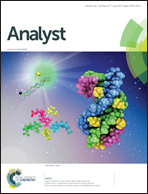Development of a highly sensitive fluorescent light-up probe for G-quadruplexes†
Abstract
G-quadruplexes are higher-order nucleic acid structures that have attracted extensive attention because of their biological significance and potential applications in supramolecular chemistry. An ever-increasing interest in G-quadruplexes has promoted the development of selective and sensitive fluorescent probes as research tools for these structures. However, most current studies primarily focus on the improved selectivity of probes for G-quadruplexes. Their detection limits or ways to improve their detection limits are rarely described. In this study, a new set of di-substituted triarylimidazole fluorescent probes were designed and synthesized, with the aim of upgrading the detection limit of a lead triarylimidazole IZCM-1 for G-quadruplexes. Among these compounds, IZCM-7 was the most promising candidate. The limit of detection (LOD) value of IZCM-7 for the G-quadruplex was up to 3 nM in solution and up to 5 ng in a gel matrix. These values were significantly improved in comparison with those of IZCM-1. Further biophysical studies revealed that the fluorescence quantum yield and binding affinity of IZCM-7 for G-quadruplexes were markedly increased, and these two factors might be responsible for the significantly improved detection limit of IZCM-7. In addition, the sensitive and selective fluorescence performance of IZCM-7 for G-quadruplexes remained the same even in the presence of large amounts of non-G-quadruplex competitors, suggesting its promising application prospect.


 Please wait while we load your content...
Please wait while we load your content...